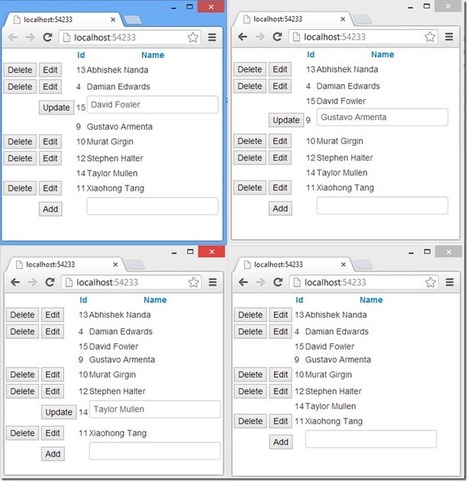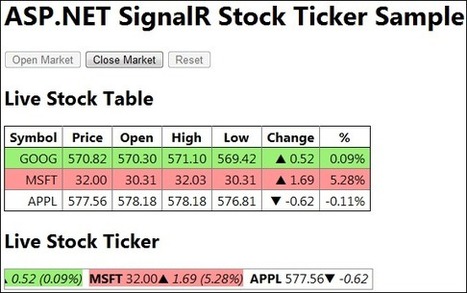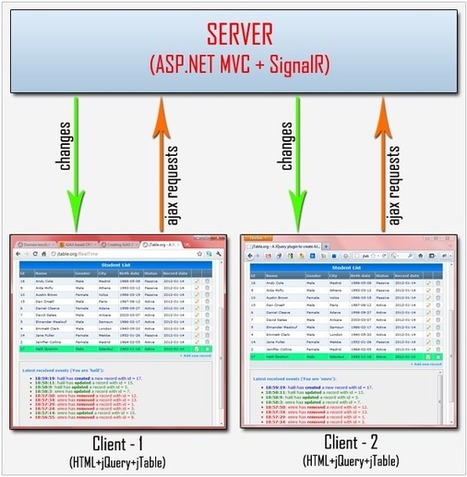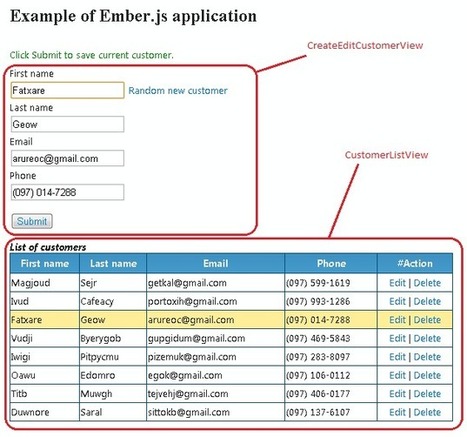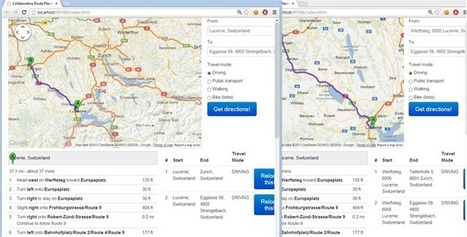 Your new post is loading...
 Your new post is loading...

|
Scooped by
William delmas
January 14, 2014 5:13 AM
|
The server side is located in the cloud and interacts with a client through event handlers which are deployed in some web application. Further, received messages are distributed to different types of client applications via SignalR: client initiates communication; server uses opened socket to return data to the client; client uses keep-alive to preserve open connection. In such a way, the CQRS events processing is provided.

|
Suggested by
Jan Hesse
November 1, 2013 7:53 AM
|
I know that SignalR has been around for a while, but I wanted to take a moment to provide a SignalR for dummies post. And for the record, I am just using the expression; never would I actually imply you are an actual dummy. Since you are viewing my site, all evicence would suggest otherwise. Eh-hem…. Well that was arrogant Chris! This post is intended not just for anyone that is new to SignalR, but also in preparation for my upcoming Desert Code Camp presentation as well as a few follow up articles I intend to write on some more advanced SignalR concepts.

|
Scooped by
William delmas
October 2, 2013 9:17 AM
|
This tutorial shows how to use ASP.NET SignalR to create a real-time chat applicationYou will add SignalR to an MVC 4 application and create a chat view to send and display messages

|
Scooped by
William delmas
July 18, 2013 2:30 PM
|
OWIN stands for Open Web Interface for .NET. Now if you are thinking, .NET already has ASP.NET and MVC and Web API, how does this OWIN thing fit in? Is it a new tool/library/web framework, and then what is Katana? Well OWIN is an open, industry standard or a specification and is primarily authored by two members of the ASP.NET Team - Benjamin Vanderveen and Louis Dejardin. You can compare OWIN with RACK in Ruby and WSGI from the Python world. For now let’s call it as a specification of interoperability between webhosts and frameworks, that outlines ‘some’ rules for building ‘certain’ types of .NET applications. The Katana project by Microsoft picks up these rules and has created an implementation of the specification. So OWIN is like the blueprint whereas the Katana project uses the blueprint to create increasingly useful set of modules that adhere to the OWIN rules. Don’t worry about what those Modules do, we’ll see that soon, for now, imprint this much, OWIN is a blueprint and Katana in as implementation.

|
Scooped by
William delmas
June 30, 2013 5:57 AM
|
SignalR started off as an OSS side project by Damien Edwards and David Fowler at Microsoft but soon it snowballed into a popular abstraction for persistent connections in .NET. With the release of Visual Studio Web Update 2012.2, SignalR was formally rolled into a part of ASP.NET and is now an open source component that is fully supported by Microsoft.In the past, we have explored interesting ways to use SignalR here on DotNetCurry. Our first SignalR post demonstrated how to use SignalR with the excellent Diff-Patch-Match library by Neil Fraser and build a collaborative ‘Review’ functionality where two people or more people can review the same post and view changes made by each other, in real time.With the release of Windows 8 and Office 2013 came One Note that had similar real-time ‘review’ functionality.
SignalR brought developers an easier way to build real-time, very responsive web applications. But, how does it play with other available technologies? I took a couple of days to implement a very common scenario needed in every Enterprise Application: A DataTable to do CRUD operations persisting changes on a database. My initial thought was this is going to be a trivial task, I have done DataTables a few times in the past. Then, I realized the real-time model with many concurrent users introduces a few challenges.
Via Jan Hesse

|
Scooped by
William delmas
May 22, 2013 9:23 AM
|
Angular JS is designed with separation of concerns in mind. One of the best architectural features of Angular JS is, it makes it easier to separate HTML and JavaScript separated from each other while playing together at the same time. Features like directives and filters can be used to easily extend Angular’s expressions and behaviour of HTML elements without wasting a lot of time and energy.

|
Scooped by
William delmas
May 15, 2013 3:30 AM
|
SignalR has been around for a while now and people are using it to build stunning real-time applications. While this worked fine on a single server deployment, there was no production ready support for running it on a multi server environment (like Windows Azure). A little over a year ago Clemens Vasters released the Windows Azure Service Bus backplane for SignalR which made it possible to deploy SignalR in a web farm.

|
Scooped by
William delmas
April 5, 2013 1:58 PM
|
In this article, I implemented an HTML table that is real time synchronized between clients over server. You can use the same mechanism to implement a chat system, a real-time stock watching system, a real time monitoring system... so on. I focused on using SignalR in this article since I have written a complete article about jTable before.

|
Scooped by
William delmas
March 22, 2013 8:42 AM
|
In this tutorial we will go through a process of building a sample shopping cart with real time capabilities. On top of that, we'll also throw in a real time admin order overview. The technologies used will include: Knockout.js - for reactive client side data bindingASP.NET Web API - as an API to retrieve data and send orders to the server sideSignalR - to notify interested parties in changes to the item stock quantities & order status

|
Scooped by
William delmas
February 2, 2013 1:28 PM
|
End to end tutorial on building a real-time tracing and logging service for ASP.NET Web API (around ITraceWriter) using SignalR
|

|
Scooped by
William delmas
December 27, 2013 8:10 AM
|
If you aren't already familiar with SignalR, it is an awesome library that allows ASP.NET developers to add real-time web functionality to their applications. For more detail about the library, check out the SignalR website. The beauty of SignalR is that it uses a fallback mechanism to connect the browser to the server. A SignalR connection starts as HTTP, and is then promoted to a WebSocket connection if it is available. This means that if the browser doesn't support WebSockets, it will fallback to the next available transport mechanism. This guarantees that you will get results, regardless of the browser.

|
Scooped by
William delmas
October 27, 2013 6:01 AM
|
In the first two parts of this series of articles, I set the groundwork for a solution that used ASP.NET MVC to create a simple site for a fictitious company called NorthWind Traders with a SQL Server database and which used R for the analytics and visualisation. Now, in the third part of the series, I’ll build on this by introducing two new R libraries that widen the analytical power of the application that we began developing in part 1 and 2. These libraries are called lattice and googleVis.

|
Scooped by
William delmas
July 19, 2013 2:04 PM
|
In today's article we'll have a look at controlling your Spotify client remotely over HTTP using a small API toolset we'll create using self-hosted ASP.NET Web API. On top of that, we'll push current the current player status to the client in real time with SignalR (self-hosted too). In the process, we will explore several other interesting technologies, such as OWIN, to provide smooth coexistence of Web API and SignalR.

|
Scooped by
William delmas
July 9, 2013 4:06 PM
|
Ember.js is a powerful JavaScript MVC framework to create complex web applications that eliminates boilerplate and provides a standard application architecture, it supports UI Bindings, Composed Views, Web Presentation Layers, and plays nicely with others. In order to create a real-time interaction web application, I add a SignalR hub and REST service with ASP.NET MVC.

|
Scooped by
William delmas
June 13, 2013 4:30 AM
|
In modern applications the end users want to get their data. They want it now, they want it up-to date. In fact it does not matter whether these are pure web application, native desktop installations or mobile apps: everybody wants his data now! For .NET-minded developers there are a numbers of options to implement near-real-time push style communication from the server/the services to the clients/consumers. You can choose plain HTTP or the super-new WebSockets features available in .NET 4.5 together with Windows 8 and Windows Server 2012. But the coolest and increasingly popular approach is to use a new framework: ASP.NET SignalR.

|
Scooped by
William delmas
May 31, 2013 4:42 AM
|
After creating my toastr post, a friend suggested marrying toastr and signalR and I thought that was a brilliant idea so I wired up a quick example. Clicking the ‘broadcast’ button will send a toast message to anybody who has the web page open!

|
Scooped by
William delmas
May 19, 2013 8:28 AM
|
The recently released ASP.NET MVC 4 beta has enhanced mobile support through the introduction of new APIs and out of box support for jQuery Mobile. The Mobile web project template helps you develop targeted mobile web applications ground up. MVC 4 also has a new 'View Switching' functionality that helps adding Mobile capabilities to an existing site in a very clean way. In this article, we will see how we can take an existing MVC 4 application that is built for the desktop browser only and add mobile views to it.

|
Scooped by
William delmas
April 12, 2013 7:23 AM
|
In this tutorial we'll explore how a couple of lines of SignalR and a few Knockout.js bindings can allow you to quickly add very exciting functionality to your application.

|
Scooped by
William delmas
April 3, 2013 5:22 PM
|
ELMAH + SignalR = ElmahR, ASP.NET real-time error monitoring aggregating dashboard; Author: Wasp.NET; Updated: 24 Mar 2013; Section: ASP.NET; Chapter: Web Development; Updated: 24 Mar 2013

|
Scooped by
William delmas
March 20, 2013 5:52 PM
|
Recently Microsoft added some new features in its ASP.NET Web Application Framework. SignalR is one of the prominent feature to build real time application e.g. social application, multiuser games, news weather etc. In real time applications server pushes the content to connected clients instantly it become available. It provides a simple ASP.NET API for creating server-to-client remote procedure calls (RPC) that calls JavaScript functions in client browsers from server-side .NET code.

|
Rescooped by
William delmas
from Web Apps
December 31, 2012 7:33 AM
|
|



 Your new post is loading...
Your new post is loading...








